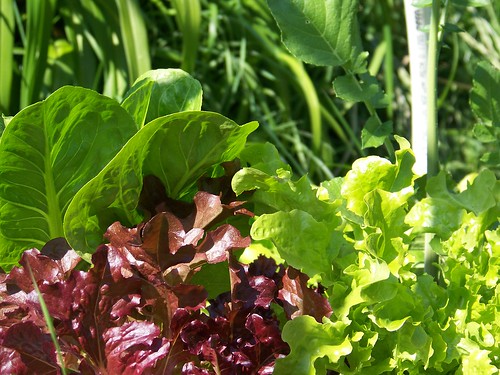 ght? It's just oil, vinegar and seasonigns, what can be so hard? I can hear the healthfood wanna be's laughing now.
ght? It's just oil, vinegar and seasonigns, what can be so hard? I can hear the healthfood wanna be's laughing now. I had the hardest time with salad dressing until just recently. It was always too oily, or too vinegary, or too salty, or not salty enough. Then I discovered an old cookbook, snitched from a public library untold years ago, in my mom's basement. The Savory Way, by Deborah Madison, one of the leaders of the Berkeley health food movement in the 1960s and 70s. The book is vegetarian and elegant, but homely too. These are the kinds of foods someone who has spent years perfecting their sense of flavors and textures makes at the end of a cocktail party, or for her own Sunday afternoon supper. Flipping through the book makes me long to live next door to her, to have the luxury of dropping in for a bowl of this or a nibble of that. Generally simple, but perfectly composed, her salads are a highlight of the book.
In one of the salad dressing recipes she mentioned her trick to perfect sald dressings - a simple ratio. She uses a ratio of 3:2, oil to acid for all of her dressings with adjustments in ingredients and additions, but not that base ratio. Three to two is almost identical to 5:3 but using that ratio allows you to mix and match your oils and acids in even more variations. A ratio also allows you to make various quantities ranging from a quarter cup of dressing for dinner for two to a quart of dressing to keep in the fridge to have on hand. Simply adjust your measuring tool. I often use tablespoons or teaspoons when making dressing for one or two, but quarter cups would make a family sized batch.
A few words about ingredients before I get into some recipes. One of the reasons we are ditching the commercial salad dressings (aside from cost - they are expensive compared to homemade!) is the polyunsaturated fats. In my post on fats I linked to a couple of articles about the health impacts of polyunsaturated fats - as in, they are really bad for you and you should work towards eliminating them completely - and also talked about the cooking fats I do use in my house. Most healthy fats are solid at room temperature, though, making them unsuitable for salad dresssings.
Olive oil is the classic choice for salad dressings. It is high in monounsaturated fat, a fat that has real health benefits, and low in polyunsaturated fats. Use caution when buying and storing olive oil, though, many olive oils are adulterated with cheaper vegetable oils, and the monounsaturated fatty acids are fragile and thus go rancid more quickly than animal fats. Buy from a reputable source and keep the oil in a cool, dark place.
Sometimes you just don't want your salad to taste like olive oil, though. Sometimes you are going for an asian flavor, or your kids balk at the olivey flavor. Check with your olive oil source and see if they have a light or second pressing oil with a more neutral flavor. You can also use some nut or seed oils (sunflower, sesame, walnut, almond, etc) for salad dressing as well. High oleic sunflower oil is a particularly good choice because it is high in monounsaturated fat and low in polyunsaturated, but it is hard to find. When buying nut or seed oils be sure to read the labels  carefully for the levels of polyunsaturated, monounsaturated and saturated fats in the oil. Ideally, you want something with low poly- and higher mono- and saturated. In any case, remember that these seed and nut oils are fragile foods that should be used in strict moderation. Buy small bottles, keep them cool and dark, and don't use them for much of anything except salad dressing. Keep cooking with your good, healthy animal fats.
carefully for the levels of polyunsaturated, monounsaturated and saturated fats in the oil. Ideally, you want something with low poly- and higher mono- and saturated. In any case, remember that these seed and nut oils are fragile foods that should be used in strict moderation. Buy small bottles, keep them cool and dark, and don't use them for much of anything except salad dressing. Keep cooking with your good, healthy animal fats.
 carefully for the levels of polyunsaturated, monounsaturated and saturated fats in the oil. Ideally, you want something with low poly- and higher mono- and saturated. In any case, remember that these seed and nut oils are fragile foods that should be used in strict moderation. Buy small bottles, keep them cool and dark, and don't use them for much of anything except salad dressing. Keep cooking with your good, healthy animal fats.
carefully for the levels of polyunsaturated, monounsaturated and saturated fats in the oil. Ideally, you want something with low poly- and higher mono- and saturated. In any case, remember that these seed and nut oils are fragile foods that should be used in strict moderation. Buy small bottles, keep them cool and dark, and don't use them for much of anything except salad dressing. Keep cooking with your good, healthy animal fats. Here is an example of a simple dressing and a few variations using Deborah Madison's magic ratio. I will use tablespoons for all my measurements because I usually make just enough for one or two meals, but feel free to scale up if you are feeding a crowd.
*** *** ***
Simple Italian Dressing
- 3 tbs olive oil
- 2 tbs red wine vinegar
- 1/2 tsp dijon mustard
- 1 small garlic clove, pressed
- goodly pinch of salt and grind of pepper
In a small jar with a lid combine the vinegar, mustard, garlic, salt and pepper. Stir with a fork until well combined. Add the oil, screw on the lid and shake until well incorporated. Taste, on a leaf of lettuce, and adjust salt or vinegar as necessary.
Asian Dressing
3 tbs high oleic sunflower oil or un-toasted sesame oil
1 tbs rice wine vinegar
1 tbs lime juice
1 tsp grated ginger
1/2 tsp grated or pressed garlic
1/2 tsp soy or fish sauce
a few grinds of black pepper
chile flakes, to taste
Combine everything but the oil in a small jar with a lid. Stir to combine and then add the oil. Screw on the lid, shake to combine then taste and adjust as necessary.
Fruity Vinaigrette
1 tbs extra virgin olive oil
2 tbs light olive oil or high oleic sunflower oil
1 tbs fruit infused cider vinegar (raspberry, blueberry, cherry, plum, etc)
1 tbs red wine vinegar
1/2 tsp honey, or to taste
a pinch of garlic powder
a very generous amount of black pepper
salt
Combine everything but the oil in a small jar with a lid and stir well to combine, getting the honey really incorporated into the vinegar. Add the oil, put the lid on, shake to combine and adjust seasoning.
Balsamic Roasted Garlic Dressing
3 tbs olive oil
1 tbs balsamic vinegar
1 tbs white wine vinegar
2 or 3 cloves roasted garlic
1/2 tsp dijon mustard
salt and pepper to taste
Mash the roasted garlic with the mustard and the salt and pepper. Stir in the vinegar until it is well combined then shake it up with the oil.
*** *** ***
The variations here are endless. Add herb, fruit or spice infused vinegars or oils, different fresh or dried herbs, different sweetners or spices. Sometimes I like to u se the brine from my home pickled vegetables. Pickled beets make a particularly beautiful and tasty salad dressing. You can stir in grated parmesan, crumbled feta or blue cheese, yogurt or sour cream. The sky is the limit here.
se the brine from my home pickled vegetables. Pickled beets make a particularly beautiful and tasty salad dressing. You can stir in grated parmesan, crumbled feta or blue cheese, yogurt or sour cream. The sky is the limit here.
 se the brine from my home pickled vegetables. Pickled beets make a particularly beautiful and tasty salad dressing. You can stir in grated parmesan, crumbled feta or blue cheese, yogurt or sour cream. The sky is the limit here.
se the brine from my home pickled vegetables. Pickled beets make a particularly beautiful and tasty salad dressing. You can stir in grated parmesan, crumbled feta or blue cheese, yogurt or sour cream. The sky is the limit here.What is your favorite salad dressing? What is your favorite salad recipe? Have you suceeded in copy catting a favorite commercial dressing? Who do you buy your olive oil from?
This post is a part of Real Food Wednesday. Check it out for more real food recipes and stories!



